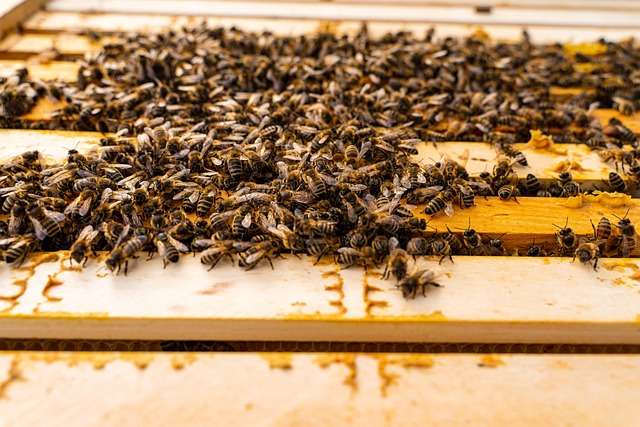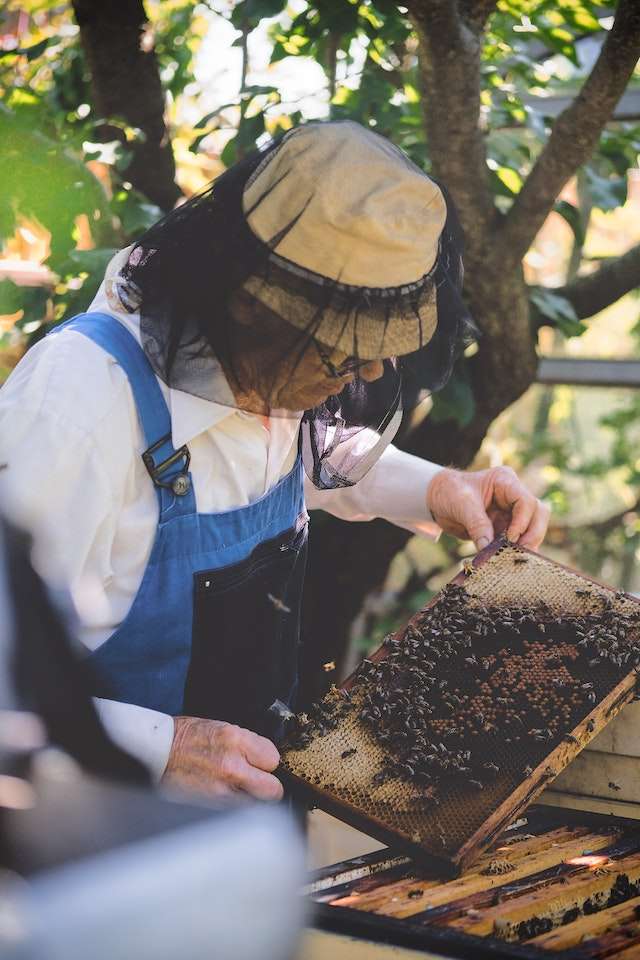What is Checkerboarding in Beekeeping?

What is Checkerboarding?
Beekeeping has been an ancient practice dating back to over 4,500 years ago in Egypt. Over time, beekeepers have developed numerous techniques to raise bees for honey, beeswax, and other bee-related commodities. One such technique used today by many beekeepers is checkerboarding.
Checkerboarding is a form of hive manipulation that aims to increase honey production by promoting comb formation and passage clearance. Beekeepers use checkerboarding to reduce swarming tendencies, stimulate honey production, and increase the overall health of their bee colonies. This method involves moving frames alternately between the top and bottom boxes of the hive.
During the checkboarding process, beekeepers interchange honey and empty frames of comb between the brood chamber and the honey chamber of the beehive. This technique provides an empty space in the honey chamber, forcing bees to build new combs and deposit more honey inside. The bees use up their resources by producing wax combs, hence encouraging more honey flow into the newly created spaces.
The goal of wave-model checkerboarding is to create an alternating pattern of brood and honey in the hive. Beekeepers can achieve this by beginning the pattern of checkerboarding in the spring during active colony growth. As the bees continue to grow and expand, additional frames can be added to the hive. By mid-summer, beekeepers should have an alternating pattern of brood and honey, with a larger number of bees than the previous spring.
Checkerboarding is a simple technique that can benefit the health and productivity of a bee colony. When used properly, it can help reduce swarming, encourage honey production, and promote overall bee colony health. However, it is important to ensure that the comb-building activities do not disrupt the brooding process and growth of the bee colony.
Importance of Checkerboarding in Beekeeping
Checkerboarding is an essential technique in beekeeping because it helps prevent swarming and encourages the bees to store more honey. Swarming occurs when the bees feel overcrowded in their hive and decide to form a new colony. Checkerboarding creates more space for the bees to lay eggs and store honey, reducing the likelihood of swarming.
By alternating the frames of honey and brood, beekeepers can also increase the honey yield. This technique encourages the bees to store more honey in the brood box, which can be harvested later in the season. Additionally, checkerboarding can help prevent the queen from laying too many eggs in one location, which can lead to overcrowding and disease.
How to Checkerboard

To checkerboard a beehive, you need to follow these preparations:
Preparations:
1. Choose the right time to checkerboard your hive: It is important to checkerboard your hive in the spring when the colonies are building up their numbers and the risk of swarming is high.
2. Inspect the hive: Before you begin the checkerboarding process, inspect the hive to ensure that it is healthy and free of pests and diseases.
3. Have a clear space: Ensure that you have a clear space to work on where you can lay out the frames.
Materials needed:
1. A bee suit: It is essential to have a bee suit when working with bees to protect yourself from bee stings.
2. A hive tool: You will need a hive tool to pry apart the frames to create the empty comb spaces.
3. Spare frames and foundations: You need empty comb spaces to checkerboard, so you’ll need spare frames and foundations.
Steps to Follow:
1. Remove the top box: Take the top box off the hive and place it aside.
2. Checkerboard the frames: Take the frames from the top box and alternate them with the frames from the lower box. Place the empty comb spaces in between the frames.
3. Replace the top box: Place the top box back on the hive, and ensure that the frames are aligned correctly.
4. Monitor the hive: Check the hive frequently to see if the checkerboarding process is successful. It is worth noting that the checkerboarding process can be repeated in four- to five-day intervals until the hive’s population and comb-building activity have stabilized.
Benefits of Checkerboarding
- Prevent Swarming
One of the prominent benefits of checkerboarding in beekeeping is preventing swarming. Swarming is a natural reproductive behavior of honeybees. However, it can cause significant damage to bee colonies if not controlled. During swarming, bees leave the hive to look for a new home, leaving the existing colony with limited resources to survive.
By alternating honey and brood frames and leaving enough space for the queen to lay eggs, beekeepers can prevent the bees from feeling crowded and prevent them from searching for a new home.
- Increase Honey Production
Beekeepers use checkerboarding to increase the amount of honey produced by their colonies. The technique of alternating honey and brood frames ensures that the bees do not run out of space to store nectar and produce honey. When there is enough space, the bees are more likely to continue foraging and bringing in more nectar, which translates into more honey yield.
- Prevent Congestion
Checkerboarding in beekeeping can also help prevent congestion in the hive. Congestion can occur when the bees run out of space in the brood chamber and start storing nectar and pollen in the honey supers, which are meant for honey storage. This overcrowding can lead to the formation of wild comb, which can be difficult for beekeepers to manage.
By alternating honey and brood frames, and giving the queen enough space to lay eggs, beekeepers can prevent congestion in the colony and reduce the likelihood of wild comb formation.
Possible Risks
However, there are also some potential risks associated with checkerboarding that should be taken into consideration.
These include:
- Bee aggression
Checkerboarding can sometimes trigger aggression in bees, particularly if the process is not carried out carefully. To minimize the risk of bee stings, it is important to wear protective clothing when working with your bees, and to move slowly and calmly throughout the process.
- Queen loss
While checkerboarding can be an effective way to encourage more efficient egg-laying, it can also lead to the loss of your queen bee. This is because the queen may become disoriented or lost during the process, making it difficult for her to find her way back to the main hive. To prevent this from happening, it is important to keep a close eye on your bees throughout the checkerboarding process and to be prepared to intervene if necessary.
- Overfeeding
Finally, it is possible that checkerboarding may lead to overfeeding of your bees. This can occur if the bees become distracted by the sudden influx of food in their new location and begin to overconsume. To prevent this from happening, it is important to monitor your hives carefully after checkerboarding and to adjust the amount of food you are providing as necessary.
Final Tips and Advice
Checkerboarding is a simple technique that can benefit beekeepers in many ways. If you are new to beekeeping, be sure to research and learn more about checkerboarding before implementing the strategy. Remember, beekeeping takes patience and knowledge, but with the right techniques and care, you can establish a healthy and productive hive.
Conclusion
Checkerboarding is a useful technique that beekeepers can use to boost honey production and encourage colony growth. As with any beekeeping practice, it is essential to understand the intricacies of the technique and use it at the proper time to maximize its benefits for the bees.
FAQ

What is checkerboarding in Beekeeping?
- Checkerboarding is a method used in beekeeping to promote the production of honey and the growth of the hive. It involves alternating the position of frames within the hive, allowing for more space for bees to store honey and pollen.
How is checkerboarding an effective technique?
- Checkerboarding helps to stimulate honey production and encourage the growth of the bee population. The change in the position of the frames allows for better ventilation and air circulation, which is essential for healthy beehives.
When should I use checkerboarding in my beehive?
- Checkerboarding is typically used in the spring and fall when the bees are actively foraging for nectar and pollen. This technique helps to ensure that the hive has plenty of space to store honey, which will be essential for the bees during the winter months.
What equipment do I need for checkerboarding?
- To use checkerboarding in your beehive, you will need a beekeeping suit, gloves, and a smoker. You will also need frames for the beehive.
How do I prepare my hive for checkerboarding?
- Before beginning the checkerboarding process, it is important to remove any excess honey or debris from the hive. You should also ensure that the frames are clean and in good condition.
What is the timeframe for checkerboarding?
- The checkerboarding process typically takes about 30 minutes to complete. You will need to check and adjust the frames every two to three weeks to ensure that they are in the correct position.
Can I use checkerboarding on any type of beehive?
- Checkerboarding can be used on most types of beehives, including Langstroth, top-bar, and Warré hives.
What are some common mistakes to avoid when using checkerboarding?
- One common mistake is not leaving enough space between the frames. This can lead to poor ventilation and air circulation, which can be harmful to the bees. It is also important to ensure that the frames are level and evenly spaced.
How often should I use checkerboarding in my beehive?
- Checkerboarding should be used as needed, typically in the spring and fall. You should monitor your hive regularly and adjust the frames as necessary to ensure that the bees have enough space to store honey and pollen.




